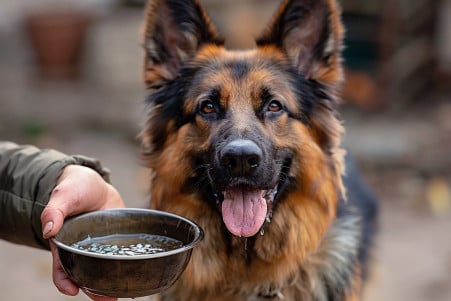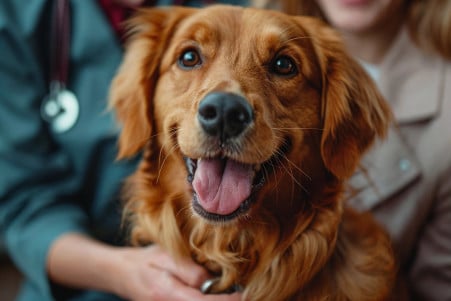Why Is My Puppy Breathing So Fast? Understanding Puppy Respiratory Rates
5 February 2024

You may have noticed that your puppy seems to breathe a lot faster than you do, and you’re probably wondering why. There are a few reasons why your puppy might be breathing fast, including their higher metabolic rate, excitement, stress, and heat.
That said, the average respiratory rate for puppies at rest is between 15–40 breaths per minute. If your puppy is breathing heavily or breathing faster than normal and there’s no obvious cause, it could be a sign of an underlying health issue, which means you should take them to the vet.
In this article, we’ll use information from veterinarians and animal physiology research to explain the ins and outs of why puppies breathe fast. We’ll cover everything from environmental factors to normal behavior and how to tell the difference between normal panting and something more serious.
By breaking down the research, we hope to give you the information you need to better understand your puppy’s respiratory health and know when it’s time to get help from a professional.
What are the most common causes for rapid breathing in puppies?
What Are Normal Puppy Breathing Rates?
Puppies are known for their exuberance, and their breathing rates are one way they show it. On average, a healthy puppy’s breathing rate is between 15 and 40 breaths per minute when they’re at rest.
This is in contrast to the average adult dog’s breathing rate of 10 to 30 breaths per minute, according to BetterPet and Mooresville Animal Hospital. This difference is due, in part, to the fact that puppies have higher metabolic rates than adult dogs. As a result, their bodies need more oxygen to support their growth and development.
Puppy breathing rates are also influenced by their activities, including play and sleep. For example, a puppy may pant after playing to cool down and lower its body temperature back to normal. Panting is an important way that dogs regulate their body temperature, and it’s necessary for puppies since they don’t have the ability to sweat like humans.
Meanwhile, sleep, especially during the REM phase, can lead to short periods of rapid breathing, which is normal for puppies, according to Canine Journal.
Healthy breathing rates are important for puppies’ growth and development. They ensure that puppies get the oxygen they need to support their high metabolic rates and help them maintain their body temperature. As a result, it’s important for pet parents to understand what’s normal when it comes to panting so they can tell the difference between a healthy, happy puppy and one that may need medical attention.
How to Tell If Your Puppy’s Breathing Is Abnormal
Knowing how to recognize abnormal breathing in puppies is important for their overall health and wellness. Signs of abnormal breathing can include fast breathing, heavy breathing, noisy breathing, coughing, or even a change in the color of their gums.
According to Rover.com, a normal resting respiratory rate for puppies is between 15 and 40 breaths per minute. If your puppy’s breathing rate is well above or below this range, especially if it’s accompanied by other symptoms like lethargy, excessive drooling, or vomiting, it could be a cause for concern.
Pawsafe explains that there are many reasons why a puppy may experience abnormal breathing. One of the most common causes is a respiratory infection, such as kennel cough or pneumonia, which may also cause wheezing or a runny nose. Heart problems, while less common in puppies, can also cause fast breathing, lethargy, and coughing.
Keeping an eye on your puppy’s breathing is important because it can help you catch potential health issues early.
According to Vet Help Direct, in addition to fast breathing, if your puppy is experiencing other symptoms like a fever, vomiting, or diarrhea, it could be a sign of an illness that needs to be treated by a vet as soon as possible.
To make sure you catch any potential health problems early, it’s important to know what to look for, accurately measure and monitor your puppy’s breathing, and be on the lookout for any changes that could be cause for concern.
How to Measure Your Puppy’s Breathing Rate
Measuring your puppy’s breathing rate at home is easy and can be extremely helpful in monitoring your puppy’s health. To do this, watch your puppy when it is calm or sleeping, as the resting respiratory rate is the most reliable indicator of health.
The Animal Emergency & Referral Center of Minnesota explains that the normal resting respiratory rate for dogs and cats is between 12–30 breaths per minute. To measure your puppy’s breathing rate, count the number of breaths your puppy takes in 30 seconds and then multiply that number by two to get the number of breaths per minute.
It’s important to establish a baseline for your puppy’s normal breathing rate so that you can compare it to future measurements. According to Service Dog Training School.org, normal breathing rates can vary from puppy to puppy, so it’s important to know what is normal for your dog.
Make sure to take note of any consistent changes from the baseline, especially if the rate is consistently higher than 30 breaths per minute when your puppy is at rest, as this could be a sign of a health problem.
Keep a record of these measurements and any circumstances that may have affected the rate, such as exercise or sleep.
According to GoPetFriendly.com, you should also keep track of these measurements over time and record any changes that are significant enough to make you think that you should consult a vet.
This information can be helpful to your vet in assessing your puppy’s health and making sure that they get the care that they need. Make sure to continue to monitor your puppy’s breathing patterns so that you can help them maintain good respiratory health and catch any problems early.
Environmental Factors That Impact Puppy Respiratory Rates
Environmental factors like temperature, humidity, and air quality are all important in determining a puppy’s respiratory rate. Puppies will pant more in order to regulate their body temperature in higher temperatures, and higher humidity can make it harder for them to breathe.
Air quality, both inside and outside, is especially important. A study in Veterinary Medicine and Science found that dogs can have worse respiratory problems due to poor indoor air quality, which includes high levels of particulate matter (PM2.5) and volatile organic compounds (VOCs).
In fact, the study found that dogs with naturally acquired bronchial/lung diseases are more likely to have a hypercellular response in their lower airways when they are exposed to poor indoor air quality.
To protect puppies, experts recommend limiting their exposure to negative environmental factors. The Guide Dogs blog suggests that puppies be kept in air-conditioned environments when the air quality is poor.
Owners should check the Air Quality Index (AQI) and avoid strenuous outdoor activities when the air quality is high to prevent their puppies from having respiratory issues. It’s important to make sure that the air in the environment is clean and filtered to make sure that a puppy’s respiratory system is healthy and that they are comfortable as they develop.
Understanding Breed-Specific Breathing Rates and Risks in Puppies
There are certain breeds of dogs that have faster breathing rates because of their physical characteristics. For example, brachycephalic dogs, like bulldogs and pugs, have short noses and flat faces that are very different from other breeds.
A study published in PubMed by C. Kurpershoek explains that this leads to a breathing pattern that is different from the normal pattern because of the upper airway obstructions that are part of their anatomy.
In addition, in Today’s Veterinary Practice, Elizabeth A. Rozanski explains that breed-specific respiratory diseases, like brachycephalic obstructive airway syndrome (BOAS), are common in dogs. Breeds with short muzzles are often affected by BOAS, which can lead to breathing problems and faster breathing rates.
A review in PMC of the epidemiology of upper respiratory tract disorders found that brachycephalic breeds have a higher relative risk of these disorders, which shows the importance of knowing about breed-specific risks. It’s important to know and understand these breed-specific characteristics and diseases so that you can accurately determine if a puppy’s fast breathing is normal or a sign of a health problem.
This knowledge is important not only for short-term health but also for long-term health. It’s important for pet parents to stay informed so that they can make sure their puppies, no matter what breed they are, live long, healthy lives with the right care and attention to their specific respiratory needs.
In Conclusion: What You Need to Know About Puppy Breathing Rates
This article has covered a lot of ground on the topic of puppy breathing rates, but the most important thing to take away is the difference between normal panting and signs of distress.
We’ve also learned that puppies breathe faster than adult dogs because of their higher metabolism, and that there are a number of other things that can affect their breathing rate, including play, sleep, and the temperature of their environment. We’ve also discussed how environmental factors and breed differences can play a role in a puppy’s breathing rate.
It’s important to know the difference between normal and abnormal breathing rates in puppies so that you can be aware of when your puppy’s rapid breathing may be a sign of a bigger problem.
It’s also important to know that you should always be on the lookout for changes in your puppy’s breathing rate, especially when they’re at rest, and to seek out a vet’s help if you notice any changes that don’t go away.
In the end, it’s important to remember that knowledge is power. The more you know about your puppy’s breathing rate, the better you can take care of them and help them grow into happy, healthy dogs. Your attention to their breathing rate can help you catch potential problems early and give you peace of mind.


